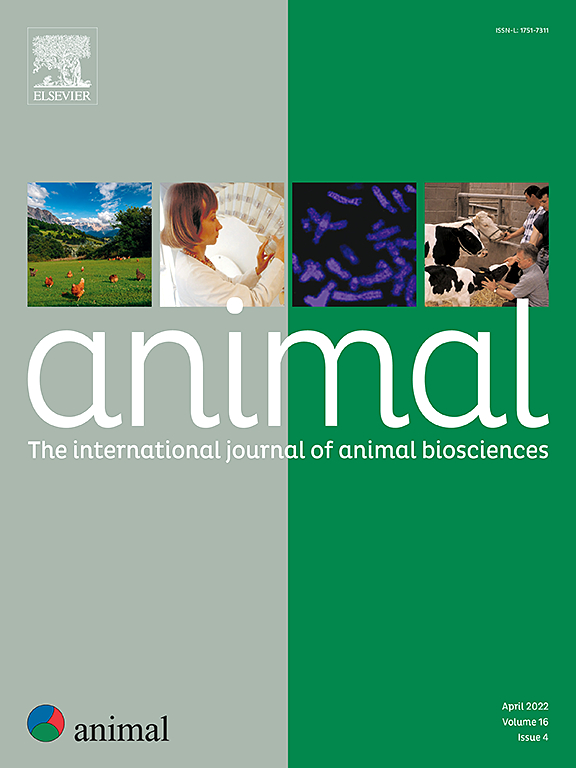A practical approach to assess the resilience attributes of livestock farms
IF 4.2
2区 农林科学
Q1 AGRICULTURE, DAIRY & ANIMAL SCIENCE
引用次数: 0
Abstract
There is a growing interest in studying farm resilience. Typically, resilience assessments focus on crisis outcomes, with less attention paid to assess the system characteristics that contribute to building resilience, i.e. resilience attributes. This is partly due to a lack of practical approaches to assess these attributes. The objective of this paper is to develop a practical approach to assess and compare the status of livestock farms’ resilience attributes in different farming systems. We identified 21 resilience attributes that generally contribute to farm resilience based on a literature review. We operationalised resilience attributes into 85 indicators quantifiable through primary farm data, such percentage of feed produced on the farm. We assessed three small ruminant case studies in Spain: (i) meat sheep farms in Aragón; (ii) dairy sheep farms in the Basque Country and Navarre; (iii) dairy goat farms in Andalusia. We conducted farmer surveys (n = 144) to measure the indicators, and organised three workshops with farmers and other local stakeholders (n = 20) to assess the importance of the resilience attributes in the three case studies. We aggregated indicators into resilience attribute scores using a minimum–maximum normalisation procedure. Using stakeholders’ assessments, we calculated attribute weights by a budget allocation process. Attribute scores and weights were then used to calculate an overall resilience score (ranging from 0 to 100). The comparison of attribute scores revealed strengths and weaknesses for resilience in each case study. In the meat sheep system, honours legacy was a major strength, while work and quality of life was a weakness. In the dairy sheep system, sector organisation was a major strength, while the redundance of productive alternatives was a weakness. For dairy goat farms, the infrastructure of the areas where farmers live was a major strength, but feed autonomy and the attributes related to the access and use of natural resources were weaknesses. The perceived importance of attributes (weights) differed across cases. Particularly, human capital emerged as one of the most relevant ones across case studies. Farms’ overall resilience scores were significantly lower in the dairy goat system. Our approach allows to find what attributes build resilience in farms and to highlight areas of improvement to strengthen their resilience. Our findings are of importance to farmers, technicians and policymakers who are interested in assessing resilience as we provide a practical approach to quantify and compare resilience of farms.
一种评估畜牧场恢复力属性的实用方法
人们对研究农场的恢复力越来越感兴趣。通常,弹性评估侧重于危机结果,较少关注评估有助于建立弹性的系统特征,即弹性属性。这部分是由于缺乏评估这些属性的实际方法。本文的目的是开发一种实用的方法来评估和比较不同农业系统中畜禽养殖场的弹性属性状况。根据文献综述,我们确定了21个弹性属性,这些属性通常有助于农场的弹性。我们将弹性属性运用到85个指标中,这些指标可以通过主要的农场数据(如农场生产的饲料百分比)进行量化。我们评估了西班牙的三个小型反刍动物案例研究:(i) Aragón的肉羊养殖场;(ii)巴斯克地区和纳瓦拉的奶羊农场;(iii)安达卢西亚的奶山羊养殖场。我们进行了农民调查(n = 144)来衡量这些指标,并组织了三次与农民和其他当地利益相关者(n = 20)的研讨会,以评估三个案例研究中弹性属性的重要性。我们使用最小-最大规范化程序将指标汇总为弹性属性分数。使用利益相关者的评估,我们通过预算分配过程计算属性权重。然后使用属性得分和权重来计算总体弹性得分(范围从0到100)。属性得分的比较揭示了每个案例研究中弹性的优势和劣势。在肉羊制度中,荣誉遗产是一个主要的优势,而工作和生活质量是一个弱点。在奶羊系统中,部门组织是一个主要的优势,而生产替代的冗余是一个弱点。对于奶山羊养殖场来说,农民居住地区的基础设施是一个主要优势,但饲料自主权和与获取和利用自然资源相关的属性是劣势。感知到的属性(权重)的重要性在不同情况下是不同的。特别是,人力资本成为案例研究中最相关的因素之一。在奶山羊系统中,农场的整体恢复力得分明显较低。我们的方法可以发现哪些属性在农场中建立弹性,并突出改进的领域,以加强他们的弹性。我们的研究结果对那些对评估弹性感兴趣的农民、技术人员和政策制定者很重要,因为我们提供了一种量化和比较农场弹性的实用方法。
本文章由计算机程序翻译,如有差异,请以英文原文为准。
求助全文
约1分钟内获得全文
求助全文
来源期刊

Animal
农林科学-奶制品与动物科学
CiteScore
7.50
自引率
2.80%
发文量
246
审稿时长
3 months
期刊介绍:
Editorial board
animal attracts the best research in animal biology and animal systems from across the spectrum of the agricultural, biomedical, and environmental sciences. It is the central element in an exciting collaboration between the British Society of Animal Science (BSAS), Institut National de la Recherche Agronomique (INRA) and the European Federation of Animal Science (EAAP) and represents a merging of three scientific journals: Animal Science; Animal Research; Reproduction, Nutrition, Development. animal publishes original cutting-edge research, ''hot'' topics and horizon-scanning reviews on animal-related aspects of the life sciences at the molecular, cellular, organ, whole animal and production system levels. The main subject areas include: breeding and genetics; nutrition; physiology and functional biology of systems; behaviour, health and welfare; farming systems, environmental impact and climate change; product quality, human health and well-being. Animal models and papers dealing with the integration of research between these topics and their impact on the environment and people are particularly welcome.
 求助内容:
求助内容: 应助结果提醒方式:
应助结果提醒方式:


